If you are searching for dog car sickness remedies, look no further. Integrative veterinarian Dr. Julie Buzby provides practical, easy-to-follow steps for reducing car-related anxiety. Plus, discover dog car sickness natural remedies and dog car sickness medicines (over-the-counter and veterinarian-prescribed).
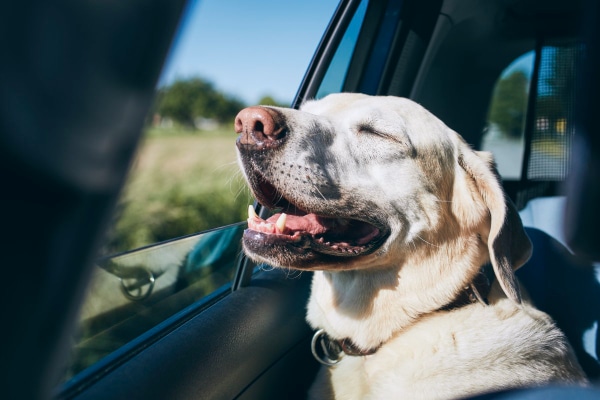
If you are dreading the next car trip with your drooling, anxious dog you aren’t alone. In fact, a recent study indicated that 48% of dog parents have noticed signs of motion sickness in their canine companions.
Understandably, car sickness can put a big damper on car trips with your dog. In a recent study, 46% of dog parents indicated that dog car sickness weakened their bond with their dog. And 83% of dog parents would travel more with their dog if it wasn’t for the fact that their dog gets car sick.
These statistics make me sad because I want dog parents and their beloved dogs to be able to enjoy life together to the fullest—and in many cases, doing so includes taking car rides together.
Hopefully, with the information below, you will be able to find some car sickness remedies that work for your dog.
Why do dogs get car sick?
In my article, Why Do Dogs Get Carsick? I discuss the causes of dog car sickness in detail. But I want to briefly review them here so you can get a better idea of which car sickness remedies might work best for your queasy pup.
In general, dogs get car sick for three main reasons (or a combination of these reasons):
- Inner ear problems—The inner ear sends information to the brain about movement and position in space. If the inner ear is damaged by an inner ear infection (i.e. otitis in dogs), vestibular disease in dogs, or, in the case of puppies, isn’t fully developed, the dog may be prone to car sickness.
- Car-related anxiety—If the dog rides in the car infrequently, associates the car with feeling sick or going somewhere unpleasant, picks up on your stress while driving, or finds the inside of the car uncomfortable (e.g. too hot, too loud, too much unstable motion) he or she may feel anxious. And as the anxiety builds, it may turn into car sickness.
- Already feeling nauseous—If the dog ate something that upset his or her stomach, or has a medical condition that causes nausea and vomiting (e.g. kidney failure in dogs, liver disease in dogs, or pancreatitis in dogs), he or she may be more likely to experience motion sickness.
How do you help dogs with car sickness?
Once you know why your dog is getting car sick, you can figure out which remedies best address that problem. For example:
Is your dog a puppy? If so, he or she may grow out of car sickness by about one-year-old. In the meantime, you can focus on making the car ride a positive experience. This can help your dog avoid developing car-related anxiety in the future.
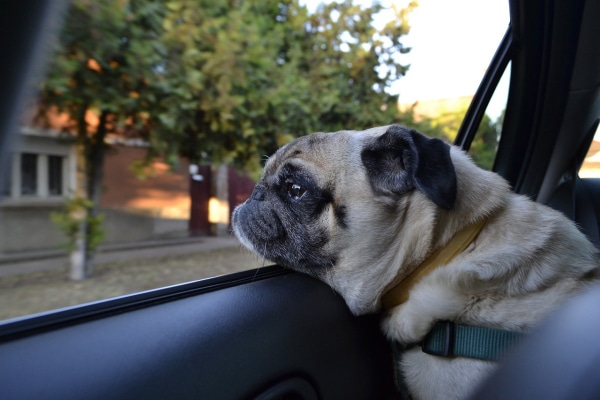
Alternatively, does your adult dog have an inner ear infection, vestibular disease, or a nausea-causing condition? In those situations, working with your vet to manage the underlying problem is the most effective way to help prevent future cases of motion sickness. And the car sickness remedies I’ll share in a bit can help too.
Or, like the majority of my car-sick patients, does your dog have some car-related anxiety? In this situation, medications and natural remedies do play a role in helping reduce anxiety in the car. But “car training” and continued positive experiences in the car are the most important components for reducing car sickness.
How do you train your dog to ride in the car?
Riding in the car is not on most dog parents’ lists of tricks and behaviors to teach their new puppy or dog. But it’s a very important step that can make a huge impact on the success of future car travel. It’s also an easy natural remedy for dog motion sickness.
Follow these steps to get your dog riding happily in the car:
1. Keep it positive
When training your dog to ride in the car, it is important to keep the experience positive for your dog. Train on days when you are not stressed and you have time to devote to the training.
2. Start with just sitting in the parked car together
The first step is desensitizing your dog to the car. If your dog has learned that the car equals “something bad,” then you need to undo this thought. Get in the car with your dog for a few minutes for several days. Don’t drive anywhere, and don’t even turn the car on. Instead, pet your dog and use toys or treats to reward him or her for sitting in the car.
3. Turn the car on but don’t drive it
After doing this a few times, your dog should appear less anxious when getting in the car. At this point, you can try turning on the car. Still don’t drive anywhere—just let the car idle in the driveway.
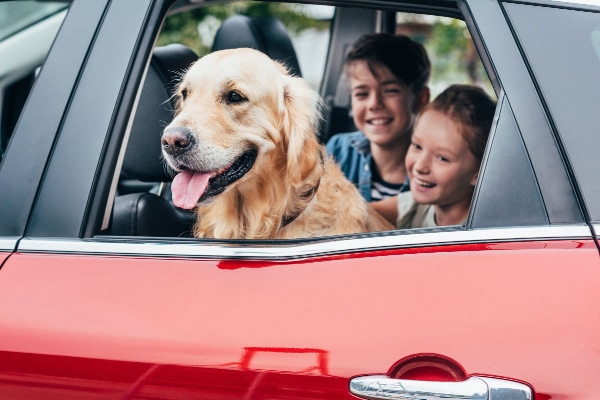
The first few times you do this, give your dog lots of positive attention. Maybe bring special toys or treats to the car. This will teach your dog that the car means he or she gets a reward rather than something scary.
4. Drive down your street and back again
When you think your dog is ready, it’s time to increase the amount of time in the car. The next step is to begin taking your dog for short drives. The first drive should only be a few minutes long. I usually recommend that dog parents go up the street, turn around, and come right back home.
Even during these mini trips, ensure your dog is comfortable (tips on this in the next section), and that you are keeping the experience positive.
5. Increase the time and distance of the drive
If this trip is successful, you can try gradually building up the amount of time and distance that you drive. Continue to bring your dog a special toy or treat to focus on in the car. If you are going to stop somewhere other than home, make sure that it is a place your dog has a positive association with—such as a pet store, dog park, or a friend’s house.
However, don’t leave your dog in the car alone. He or she might fear you are leaving him or her behind. This can create a negative association with the car. Plus, especially in the summer, there’s the risk that the car could get too hot, leading to your dog overheating. Or worse yet, your furry friend could develop life-threatening heat stroke in dogs.
6. Don’t be afraid to take a step back if necessary
As you are increasing your drive time, your dog should continue to be calm and not experience car sickness. If your dog does become anxious or sick, remain calm and don’t punish your dog. The stress could make it worse.
For the next few trips, take a step back. Decrease the amount of time in the car to help your dog learn that he or she is still okay and safe. Then work back up to longer drives again.
7. Refresh your dog’s “car training” regularly
Once your dog is desensitized and trained to ride in the car, congratulations! You just completed a very important and beneficial step for both you and your dog. If your dog does not ride in the car regularly, I recommend repeating parts of this training every once in a while as a refresher course.
If your dog isn’t a frequent car rider, is also important to take your dog on car drives to non-scary places occasionally. That way your dog doesn’t learn that the car only means going to the vet, groomer, or boarding kennel.
How do you keep your dog comfortable in the car?
In addition to training your dog to ride in the car, it is important that you keep your dog comfortable when he or she is a passenger. Here are some of my favorite ways to make your dog feel like a first-class traveler:
Keep the car cool
If your dog is hot in the car, he or she is more likely to feel nauseous. Turn on the air conditioning for your dog or roll the windows down for some fresh air. This will also help provide good airflow for your dog.
Bring something familiar from home
If you bring a blanket, bed, T-shirt, or toy from home, it can act as something familiar for your dog. This will help your dog feel comfortable and relaxed in the car.
Bring a special toy or treat
As mentioned in the “car training” section, a reward that is unique to car rides can help make your dog excited for the trip. It is also a great distraction from everything that is going on in and around the car. However, always ensure it is a safe chew toy for dogs.
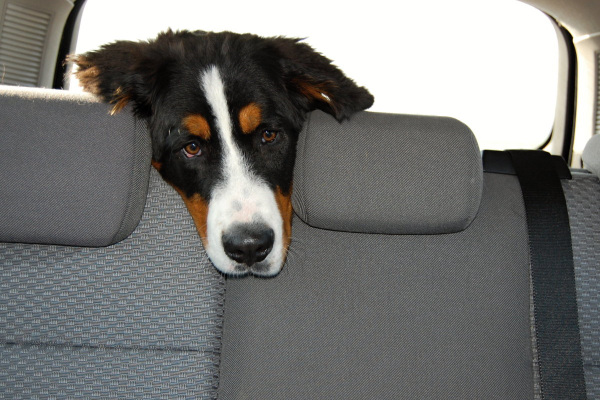
Turn down the music
While louder music might be relaxing to you, it can hurt your dog’s ears and make him or her more nervous. Turn the music down to a lower volume. And if you normally prefer music that has harsh sounds or screaming-like noises, maybe try playing something calmer so your dog doesn’t become anxious.
Offer water often
If you are going for a long drive, offer your dog fresh water regularly. This can help keep your dog cool in the summer and keep him or her properly hydrated all year long.
Avoid large meals before traveling
If you are going for a longer drive, try to avoid feeding your dog for 8-12 hours before the road trip (as long as this won’t cause anxiety in your dog). An empty stomach is less likely to make your dog feel nauseous than a full one.
However, some dogs may do better with a tiny meal so they don’t have a totally empty stomach. You may have to experiment a little to figure out what is best for your dog.
Stay calm
Your dog can detect your own anxiety and stress very easily, so it’s best if you remain calm when in the car. Try to avoid sharp turns or yelling at other drivers. If you are calm, your dog is more likely to travel stress-free.
Use a dog seat belt, dog car seat, or crate
I often get asked, “Do dog car seats, dog seat belts, or crates help with car sickness?” The answer is, “Yes!” These are great ways to help your dog feel secure and safe in the car. They also help prevent younger dogs or nervous and excitable dogs from moving around in the car and distracting the driver. (And in the case of an accident, having your dog restrained in a seat belt or crate also helps prevent injury to you or your dog.)
Which of these options you pick depends on your dog. Many dogs feel safe in their carriers or kennels, making them a great choice. (But ensure you secure the crate so it can’t slide around.) Other dogs may prefer to wear a dog seat belt and ride in a car seat designed for small dogs, on the seat of your car, or on a bed in the back of an SUV or van.
Using these tips to make the car as comfortable as possible can, hopefully, reduce your dog’s anxiety. And in turn, this can function as a car sickness remedy by preventing your dog from feeling nauseous while traveling.
Are there dog car sickness medicines?
However, sometimes you may do your best to get your dog accustomed to the car and make it comfortable for him or her. Yet your dog keeps experiencing car sickness. In that case, your dog might benefit from dog car sickness medicines.
When talking about car sickness, owners often ask me if there are human motion sickness pills or other medications that their dog can have for car sickness. And indeed there are. Let’s start by taking a look at the over-the-counter medications to help with car sickness. Then we can talk about the prescription options, which are often more effective.
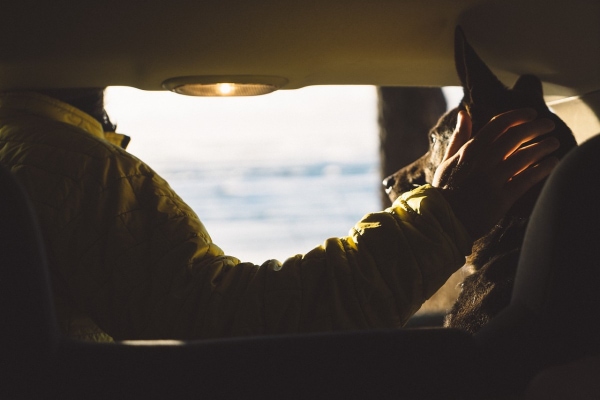
Over-the-counter dog car sickness medicines
Some common OTC motion sickness medications dogs can take include:
Dimenhydrinate (Dramamine® and Gravol™)
Like people, dogs can take Dramamine for car sickness. This antihistamine can reduce brain activity and signals that trigger nausea in dogs—reducing motion sickness. Dramamine should be taken at least 30 minutes prior to travel. It’s safe for dogs, but it can can cause sedation or be less effective than other choices for car sickness.
Diphenhydramine (Benadryl®)
Benadryl for dogs is another antihistamine that can help with motion sickness when traveling in the car. It may reduce nausea and can make a dog sleepy rather than being anxious. However, there are much better medications available for car sickness.
L-Theanine (Solliquin®)
Solliquin is a calming medication that contains L-theanine, an amino acid naturally found in green tea. This amino acid stimulates brain waves that create a sense of relaxation and peace in your dog’s brain. Thus, Solliquin has calming effects to help with your dog’s anxiety in the car. But it does not directly target nausea.
Prescription dog car sickness medicines
Often, prescription medications are more effective at controlling the nausea and anxiety associated with car sickness. Some useful options include:
Maropitant (Cerenia®)
Cerenia for dogs is a veterinary-specific anti-nausea medication that works by blocking signals in the brain that trigger nausea. Vets often use Cerenia to treat acute vomiting from GI upset or other conditions and to prevent motion sickness in dogs. Personally, I love Cerenia, and it is one of my favorite choices for preventing car sickness in dogs.
In a study evaluating the efficacy and safety of Cerenia for the prevention of vomiting due to motion sickness, a dose of Cerenia decreased vomiting by 86.1% compared to a placebo when given two hours prior to travel. And even when given 10 hours before the trip, it still decreased vomiting by 76.5%.
When using Cerenia to prevent car sickness, your vet will probably have you give your dog a small amount of food and the Cerenia tablets at least two hours prior to leaving. This gives the Cerenia time to take full effect.
Since one dose lasts for 24 hours, you don’t have to worry about it wearing off in the middle of a longer trip. Plus, it doesn’t usually cause sedation like some of the other car sickness medications. This means your dog will be alert and ready to have fun when you get to your destination.
Meclizine (Antivert®, Simply Motion®, Bonine®, and Travel Sickness®)
Meclizine for dogs is another one of my favorite medications for dog car sickness. It works by blocking certain signaling molecules in the brain. This “slows down” brain activity related to the vestibular system (i.e. the system that gives information about motion) and decreases the feeling of nausea—therefore preventing vomiting.
Dogs can take meclizine for motion sickness related to car rides or vestibular disease. Meclizine should be given 30 to 60 minutes before traveling and can last for 3 to 6 hours.
Ondansetron (Zofran®)
Since my clients tend to ask me about it, I wanted to mention that Zofran is not nearly as effective for car sickness in dogs as Cerenia and meclizine. Therefore, while it does a great job of controlling nausea from medical conditions, Zofran is not typically a top choice for preventing nausea from motion sickness in dogs.

Anti-anxiety medications
If your dog is still anxious in the car even after training, he or she may continue to feel car sick when traveling. In these cases, I recommend talking to your veterinarian about an anti-anxiety prescription. Some dogs can benefit from medications like trazodone for dogs, gabapentin for dogs, or fluoxetine to reduce their anxiety. That way they can be relaxed when traveling and not feel sick.
Talk to your vet before giving any medications
If you think your dog needs over-the-counter or prescription medications to help with car sickness, please consult your veterinarian before giving your dog one of the options above. Not only do you want to make sure a specific medication is safe for your dog, but some drugs will be more effective for your dog than others.
What about natural remedies for dog car sickness?
Sometimes dog parents prefer non-medication options or want to have something to use in addition to a prescription. This is where natural options can come in. Some natural remedies for anxious or car sick dogs include:
Adaptil®
One option is the Adaptil collar or spray. Adaptil is the synthetic version of a pheromone that is naturally emitted by mother dogs to calm and relax their puppies. This pheromone is only detectable by dogs, so humans can’t smell it at all. The Adaptil collar diffuses this pheromone to help calm a dog and decrease anxiety. And the spray works in a similar way.
For dogs who experience motion sickness related to anxiety, Adaptil can help them feel less stressed and nauseous in the car. Adaptil collars usually last for four weeks and do not require a prescription. And a bottle of Adaptil spray (which you apply to the crate, blankets, collar, etc. but NOT directly to your dog) can last for a while.
Ginger
Ginger is one of the most common natural options used to treat motion sickness in dogs. It is believed that ginger protects the gastrointestinal tract while reducing the feeling of nausea. Dogs can take ginger extract in multiple forms (including a powder or tablet) for car sickness. However, it seems that ginger-containing products like ginger snaps, ginger dog treats, or ginger ale are probably not effective.
If you want to use ginger for your dog’s car sickness, discuss it with your veterinarian first. Show your vet what form of ginger you want to use, so the vet can make sure it is safe for your dog.
Talk to your vet before trying natural remedies or supplements
In addition to ginger, there are some other natural remedies like CBD oil for dogs or essential oils that dog parents may be tempted to try for their car sick dog. But before giving your dog any type of remedy or supplement, please consult your veterinarian first. Even natural remedies can have side effects—especially in dogs who have specific diseases or are taking certain medications. Your veterinarian is your best resource for knowing what will be safe and effective for your dog.
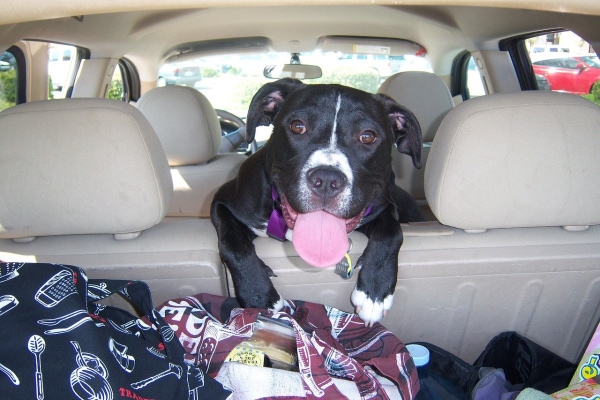
Restore the joy of car rides for your dog and you
If your dog is struggling with car sickness, please don’t give up and assume you are doomed to either leaving your dog at home or cleaning up vomit if you do take your dog somewhere. There is hope for dogs with car sickness!
Puppies can grow out of car sickness, and managing a dog’s underlying conditions can make him or her less prone to motion sickness. Plus, taking the time to desensitize your dog to the car and make it a comfortable environment for him or her can do wonders for your dog’s car anxiety. And if your dog still needs a bit of help with car sickness, you can talk to your vet about Cerenia, meclizine, or other medications and natural remedies.
There are solutions out there for car sickness—it’s just a matter of figuring out what works best for your dog. Maybe your dog will never be destined to be your constant car companion. But if you can get to the point where he or she can tolerate (or ideally enjoy) the occasional trip to the park, a friend or family member’s house, the vet, or the groomer, that is a win in my book.
Car sickness doesn’t have to stop your dog from living life to the fullest.
Which car sickness remedies worked best for your dog?
Please comment below.


I converted the back of the SUV into a nice bed. We slept throughout the night while parked in the driveway. Just several of these sessions was a significant help.
Hi Edwin,
This is a great tip! I’m so glad that it helped your pup feel more comfortable in the car. Thanks for sharing it with us!
My 3 year old Japanese Chin has never grown out of her car-sickness so it’s Cerenia for her – always works! It’s pricey so I watch for sales and stock up. Thanks for the article. I was wondering if I should try something else with her and am not familiar with Meclizine. I’ll look into that as an alternative, if I ever need it.
Hi Judy,
Too bad that your Japanese Chin wasn’t one of the dogs who outgrew car sickness. I’m glad to hear that the Cerenia has worked well for her though! Sometimes sticking with what you know works ends up being easiest, but you could definitely have a conversation with your vet about trying Meclizine if you wanted to.
Here to hoping that whatever medication you decide to use will continue to help your pup ride in the car comfortably!